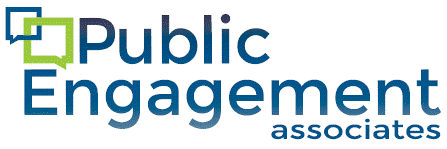A Year of Virtual Meetings
- kim17982
- Apr 17, 2023
- 4 min read
Updated: Jun 9, 2023

When Governor Hogan of Maryland announced the closing of public schools statewide on March 13, 2020, we at PEA like almost everybody, had no idea what to expect in the weeks and months to come.
On that day, Steve facilitated the first virtual steering committee meeting ever held by the Purple Line Corridor Coalition. The transition from an in-person meeting to online went smoothly. Yet, that success did not clearly signal the changes that were in store for us. Nearly every project we were working on either got delayed temporarily or put on a lengthier hold. We facilitate our next virtual meeting on May 18th with the NoMa Parks Foundation in Washington, D.C.
By that time, unlike pre-pandemic, we had in place several, annual Zoom subscriptions and were investigating other tools. Prior to spring 2020, we did not have subscriptions to any of the now popular online platforms. While we had experience with online engagement and used occasional platforms to run table facilitator and theme team orientations for at least a decade, we secured those accounts just for single meetings.
The pandemic changed that and just about everything else in our world!
Nearly a year later, we have facilitated approximately twenty, large, virtual community meetings – and smaller, multi-stakeholder meetings – using GoToMeetings, Microsoft Teams, WebEx. But far and away most often, was Zoom. Like millions of our closest friends during that same time! [as of October 2020, Zoom had more than 115 million daily users]
Our virtual meetings have included:
NoMa Parks Foundation to enable 150 residents to critique designs for public space at what will be the transformation of Dave Thomas Circle (at Florida and New York avenues in N.W. DC).
Councilmember Monique Anderson-Walker from Prince George’s District 8 in conjunction with Prince George’s Planning Department to engage a couple of hundred residents to provide feedback and guidance on an area study of Henson Creek Village that included an economic and market analysis and an environmental study.
Congressional Hispanic Caucus Institute (CHCI) to support them in converting their Annual Leadership Conference into a five-day virtual summit involving several thousand participants in more than three dozen plenaries and breakout panel sessions on a wide range of critical, national policy topics.
Purple Line Corridor Coalition (PLCC) to design and facilitate their annual stakeholder meeting for more than 150 attendees from across suburban Maryland and DC to discuss its comprehensive equitable development agenda for the corridor.
Ward 7 Action Summit for D.C. Councilmember Vincent C. Gray to facilitate his four-hour convening of nearly 200 residents that would lead to the development of his legislative agenda for his second term.
State of Ward 8 Summit for D.C. Councilmember Trayon White to facilitate his three-hour convening of 150 residents to set his action agenda across 7 policy areas for 2021.
Montgomery County Public Schools (MCPS) Districtwide Boundary Analysis to convene three large-scale, regional Public Meetings and eight smaller scale stakeholder gatherings to introduce residents and parents to an online boundary tool and solicit their input and guidance for a final report on a framework for considering boundary changes.
Prince George’s County Public Schools (PGCPS) to convene six community conversations for the first phase of public engagement for its Comprehensive School Boundary Initiative, including two Spanish-only meetings involving nearly 300 residents.
Near Northwest Safety and Mobility Study – The District Department of Transportation (DDOT) to host a series of virtual public meetings to gather community input and discuss ideas for concrete actions to increase safety and improve transportation connectivity and accessibility in communities in what is known as “Near Northwest” D.C.
In many ways, the preparation for virtual community meetings is a tad less complex, with fewer moving parts than organizing an in-person meeting. As is evident, you don’t have to secure a venue, procure a caterer, arrange transportation, set up tables and chairs, or staff a registration table.
Yet, you can’t solely depend on your trusty email invitation to fill the virtual seats either. Outreach requires equivalent effort to ensure a broadly representative group of residents to attend and participate. Outreach targets still need to be set and outreach partners need to be secured and empowered. Pre-registration largely remains the same and you still need to track the rolls closely to see what strategies need to be adjusted to bring in the “harder-to-reach” populations.
The need for an engaging meeting design, presentations with ‘punch,’ and thoughtfully constructed polling and discussion questions are mandatory tasks if you want to guarantee not just a participatory meeting, but one that leads to the results (feedback, input, perspective, insight) that you need to obtain to keep moving your project forward. Rehearsing all programmatic elements of the event ahead of time also remains essential.
At the meeting itself, all key staff members need to be crystal clear on their roles and responsibilities, whether it is a visible role (e.g., emcee, presenter, key public official) or a more invisible role (platform set-up, monitoring possible trouble spots, reviewing comments and questions, providing links to accessible documents, etc.), and be fully equipped and competent to carry out those roles in the moment.
Finally, you still need to orchestrate your follow-up – whether that is thanking participants for attending, sharing any results or themed input from the meeting, publicizing the next meetings or next steps, or informing residents who didn’t attend how they can still get up to speed and share their input asynchronously.
If you need support in planning and facilitating your virtual community meetings, please contact Steve (steve@publicengagementassociates.com) or Kim (kim@publicengagementassociates.com).




Comments